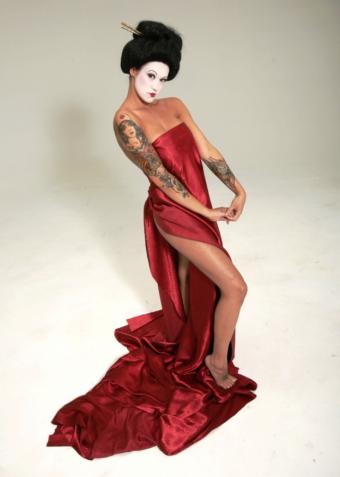Japanese Body Art Characters

Koi and Carp

Lotus Tattoo

Henna Characters

Geisha

© 2024 LoveToKnow Media. All rights reserved.

Japanese body art encompasses several traditional images. From auspicious meanings, to virtue and strength, Japanese body art is thought to convey images characteristic to the wearer.

The image of the dragon was brought to Japan from China. The image can mean protection, water, fire, wind or earth and can also be used to symbolize Buddhism. A true Japanese dragon displays three claws, but can take on many styles and characteristics. Dragon tattoo placement is typically seen on the back. This is due in part to the size and shape of the tattoo. The back is thought to give enough canvas to display the power and symbolism of the dragon. Placement of the dragon on other areas of the body is also seen when the dragon has been sized to the shape of the limb.

There are seven, heavenly virtues in Japan. These are Faith, Hope, Charity, Fortitude, Justice, Temperance and Prudence. Tattoos or body art of the seven virtues are thought to help the wearer embody these virtues. The symbols may be used together or apart and can be placed anywhere on the body. Body art of the seven virtues may also be combined with other images that help imbue these characteristics.

Japanese characters are an extremely popular body art image in both the Eastern and Western worlds. Characters can be used to spell out traits or characteristics the wearer wishes to embody, or individual letters or words. Care should be taken when selecting characters to ensure they are placed correctly and that their meaning is not misconstrued. Some Japanese characters can have different meanings in other languages, so some thought should accompany their use.

The image of koi in Japanese art dates back thousands of years. Originating in China, this image has been thoroughly absorbed by Japanese culture. The koi tattoo or body art image is extremely popular and prevalent in Japan. The fist were originally kept as auspicious or lucky pets, and the image has come to mean luck as well. Placing the image of a koi or carp on your body is thought to bring luck, health and life to the wearer.

The lotus, the peony and other flowers are traditional symbols in Japan thought to bring peace to the wearer. The lotus may be worn by someone who has just completed a difficult time of life, to symbolize their journey. Flowers are frequently paired the image of koi and are amongst the more popular designs with Japanese tattoo and body paint artists.

Henna can be found throughout the world, and is extremely prevalent in Eastern culture. Henna designs in Japan can include characters, koi, dragons and other popular images.

Geishas are no longer seen as frequently in Japan as in years past, but the image of the white-faced geisha is still a strong one. Geishas used body paints to transform their appearance into one considered beautiful. This could include painting the face and neck, and leaving occasional areas of skin showing through as a symbol of erotica.

If you are interested in some of the symbols in Japanese Body Art, consider some dragon tattoos or Buddhist tattoos.